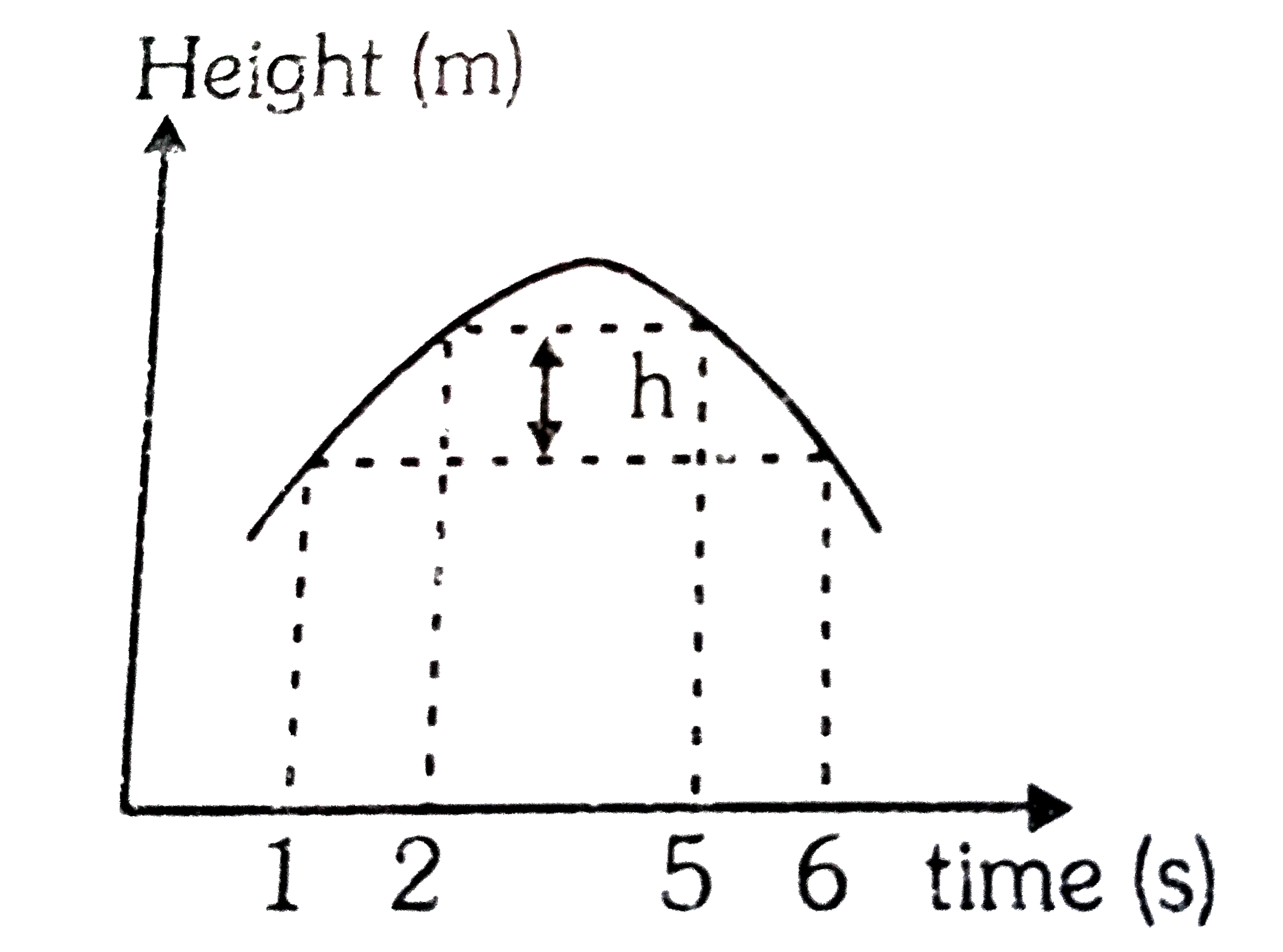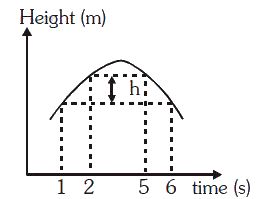A ball is thrown upwards . Its height varies with time as shown in figure. If the acceleration due to gravity is 7.5m/s2, then the height h is
 Solution in Gujrati
Solution in Gujrati
The correct Answer is:C
For returning, the starting point
Area of (ΔOAB)= Area of (ΔBCD)
12×20×25=12×t×4t⇒t=5√5≅11.2
∴ Required time =25+11.2=36.2
Topper's Solved these Questions
- BOOK - ALLEN CHAPTER - MOTION IN A PALNEEXERCISE - EXERCISE-036videos
MOTION IN A PALNE
- BOOK - ALLEN CHAPTER - MOTION IN A PALNEEXERCISE - Assertion-Reason20videos
MOTION IN A PALNE
- BOOK - ALLEN CHAPTER - MOTION IN A PALNEEXERCISE - SOLVED EXAMPLE28videos
MOTION IN A PALNE
- BOOK - ALLEN CHAPTER - KINEMATICS-2DEXERCISE - Exercise (O-2)47videos
KINEMATICS-2D
- BOOK - ALLEN CHAPTER - NEWTON'S LAWS OF MOTION & FRICTIONEXERCISE - EXERCISE (JA)4videos
NEWTON'S LAWS OF MOTION & FRICTION
Similar Questions
A point traversed half the distance with a velocity v0. The remaining part of the distance was covered with velocity v1 for half the time, and with velocity v2 for the other half of the time. Find the mean velocity of the point averaged over the whole time of the motion.
01:37View SolutionAn iron ball and a wooden ball of the same radius are released from a height ‘ h ’ in vacuum. The time taken by both of them to reach the ground is
01:44View SolutionA particle thrown over a triangle from one end of a horizontal base falls on the other end of the base after grazing the vertex. If αandβ are the base angles of triangle and angle of projection is θ, then prove that (tanθ=tanα+tanβ)
03:38View SolutionA particle is moving in xy-plane .At certain instant the components of its velocity and acceleration are as follows ux=3m/s,uy=4m/s,ax=2m/s2anday=1m/s2. The rate of change of speed at this moment is
03:53View SolutionA piece of wire is bent in the shape of a parabola y=kx2 (y-axis vertical) with a bead of mass m on it. The bead can slide on the wire without friction. It stays at the lowest point of the parabola when the wire is at rest. The wire is now accelerated parallel to the x-axis with a constant acceleration a. The distance of the new equilibrium position of the bead, where the bead can stay at rest with respect to the wire, from the y-axis is:
04:18View SolutionThe height reached in time t by a particle thrown upward with a speed u is given by h=ut-(1)/(2) "gt"^(2) where g is acceleration due to gravity. Find the time taken in reaching the maximum height.
View SolutionA rocket is fired upwards such that its engine takes 10 s to explods fully. Its velocity- time graph is as shown in the figure. Acceleration due to gravity is 10m//s^(2) . The total time for which the rocket moves upwards is
04:52View SolutionA rocket is fired upwards such that its engine takes 10 s to explods fully. Its velocity- time graph is as shown in the figure. Acceleration due to gravity is 10m//s^(2) . The maximum height attained by the rocket is
View SolutionA ball is thrown vertically upward from the ground at time t=0 s. It passes the top of a tower at t=3 s and 2 s later it reaches and its maximum height. The height of the tower is (Acceleration due to gravity, g=10m/s2)
03:34View Solutionएक गेंद उर्ध्व दिशा में फेंके जाने पर T समय में अधिकतम ऊँचाई h पर पहुँचती है । T / 2 समय के बाद उसकी ऊँचाई होगी -
04:21View SolutionA ball of mass m is thrown vertically upward from the ground and reaches a height h before momentarily coming to rest. If g is acceleration due to gravity, the impulse received by the ball due to gravity force during its flight is
05:56View Solutionएक गेंद को ऊर्ध्वाधर ऊपर की ओर फैंका जाता है। इसकी ऊँचाई समय के साथ चित्रानुसार परिवर्तित होती है। यदि गुरूत्वीय त्वरण 7.5m/s2, है। h होगी-
 03:27View Solution
03:27View SolutionA ball of mass m is through vertically upward from the ground and reaches a height h before momentarily coming to rest. If g is acceleration due to gravity, the impulse received by the ball due to gravity force during its flight is
03:29View SolutionA ball is thrown vertically upwards. It goes to a height 20 m and then returns to the ground. Taking acceleration due to gravity g to be 10 "m s"^(-2) ?, find the initial velocity of the ball
View SolutionA ball is thrown vertically upwards. It goes to a height 20 m and then returns to the ground. Taking acceleration due to gravity g to be 10m s−2 ?, find the final velocity of ball on reaching the ground
03:20View SolutionA ball is thrown vertically upwards. It goes to a height 20 m and then returns to the ground. Taking acceleration due to gravity g to be 10m s−2 ?, find the total time of journey of ball.
View Solution

